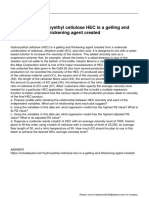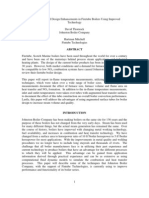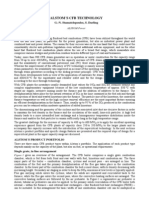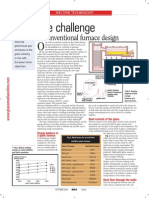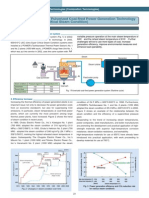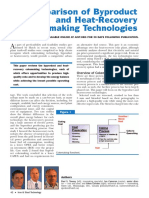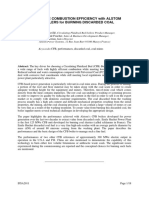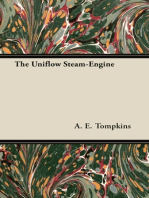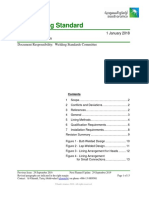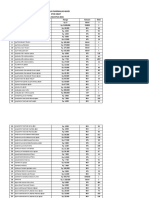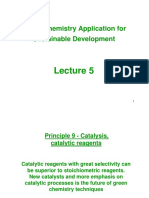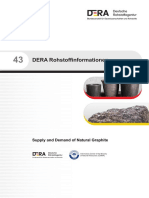Waste CFB Combustion
Waste CFB Combustion
Uploaded by
mihugirCopyright:
Available Formats
Waste CFB Combustion
Waste CFB Combustion
Uploaded by
mihugirCopyright
Available Formats
Share this document
Did you find this document useful?
Is this content inappropriate?
Copyright:
Available Formats
Waste CFB Combustion
Waste CFB Combustion
Uploaded by
mihugirCopyright:
Available Formats
RESEARCHES FOR THE UTILISATION OF SOLID WASTES IN CFBC BOILERS
Liviu G. Drago, Mihu I. F. Grjoab, Ctlin I. Flueraru ICPET-Cercetare S.A., Bucharest, Romania
Abstract The Romanian economic and energetic situation requires a large-scale implementation of clean and efficient technologies for the utilisation of different residues and wastes resulted in industry. The need of such technologies has become even more acute, since in January 1998 the new environmental regulations will become operational. This is why, in our institute, the research focused lately on the clean combustion of industrial wastes, sludge and biomass. The research works initiated aimed to establish a circulating fluidised bed (CFB) combustion and desulfurisation technology for these wastes. In the current paper, the results obtained for two types of residues are presented: a solid waste from the production of electrodes for metallurgic furnaces, and the high-sulphur petroleum coke, that is a residue from oil cracking.
Introduction The industrial development registered worldwide in the last decades has led, besides the growth of energy demand, to the accumulation of high quantities of wastes, with a negative environmental impact. As a consequence, the regulations for environment protection constrained the industrial producers to neutralise their residues or, if possible, to find an alternative use for them. Such examples are paper mill wastes, used tyres, biomass, sludge, petroleum residues. Not long ago, high sulphur petroleum coke was also considered to be among these, not being suitable for use in industry, where it should meet certain quality conditions. Once the desulfurisation technologies developed, its utilisation as a fuel in power plants became possible, in some countries - such as USA and Denmark - even being used on a large scale [1]. However, not all desulfurisation technologies provide a competitive price for the energy produced even from a low-price fuel such as delayed coke. A more attractive solution from this point of view is the circulating fluidised bed combustion (CFBC), which allows the in-bed limestone desulfurisation. The data achieved from several Romanian refineries allowed us to estimate the internal production of high sulphur petroleum coke at about 360.000 tons annually. Most of it is currently exported with 40 USD per ton, and the price could further decrease by the end of the year. In Romania, no power plants use petroleum coke as a fuel. Another potential fuel with no utilisation in Romania is the waste resulting from the production of electrodes for metallurgic ovens. In spite of its high heating value, this waste is not
being used because of the difficulties encountered at its combustion in classical furnaces. Since their utilisation seems to be both necessary and cost-efficient, we performed several combustion and desulfurisation tests with petroleum coke and electrode waste on a 1 MWt CFBC pilot plant to determine the optimum operating parameters.
Description of the test facility The experimental pilot plant is the first CFBC plant conceived in Romania. The fuel it was designed for is lignite with heating value higher than 5000 kJ/kg and the granulation 0 - 10 mm, or oil shale with 3800 kJ/kg and 7% fuel oil support. A simplified scheme of the boiler is presented in fig. 1; its main components are: furnace; cyclone; loop seal; external fluidised bed heat exchanger (FBHE); convective pass; air preheater.
The combustion takes place in the furnace, both in the dense bed from the bottom and above it, where the particle density is lower. The start-up of the plant is performed by means of a fuel oil burner that warms the fluidised bed up to the solid fuel ignition temperature, when the combustion process is initiated. Two water circuits ensure the cooling of the plant. The main cooling circuit consists of the heat transfer surfaces located in the fluidised bed ash cooler, the
furnace and the convective channel. The secondary circuit cools the ash screw conveyer and the fixed bed ash cooler. The solid fuel is introduced in the fluidised bed by means of screw conveyers. During the fluidising process, fuel particles are mixed with recirculated ash particles, burning as they are elutriated in the upper part of the furnace. For a complete combustion and in order to achieve the desired gas velocity, secondary and tertiary air is introduced at two different levels. The coarse particles that are not carried by the flue gas, are discharged through the drain pipe from the air distributor and evacuated by the water-cooled screw conveyer. The test rig is equipped with a tangential entry reverse flow single cell cyclone, where the coal and ash particles are centrifugally separated from the flue gas and fall through a duct into the siphon. The hot flue gas are evacuated at the upper part through a 90 turn and sent in the convective pass. An impact separator was fitted between the furnace and the cyclone for evaluation purpose, but only for a short period. The siphon consists of a mechanical valve and two compartments split by a dividing wall. The movement of the solids in the non-mechanical valve is facilitated by air, which is introduced through a bar grate similar to that from the furnace. Apart from its sealing function, this device makes possible the control of the fraction of ash directed into the external FBHE, by modifying the air flow in the two compartments. A strict control of the furnace temperature is obtained by diverting the solids either directly into the oxidising zone of the furnace, or into the external fluidised bed heat exchanger.
Legend:
1. 2. 3. 4. 5.
Furnace Cyclone Convective bank Secondary cyclones External FB heat exchanger 6. Coal hopper 7. Startup burner 8. Limestone hopper
9. Siphon
10. Air preheater 11. Mechanical valve 12. Heat transfer surfaces 13. Ash cooler 14. Impact separator
Fig. 1: The 1 MWt CFBC pilot plant
The external fluidised bed heat exchanger (FBHE) is used to supplement the furnace heat transfer surfaces, also making the boiler more fuel flexible. It is refractory lined, and a wall divides it in two compartments. The heat transfer surface consists of coils immersed in the bubbling bed. Bar grates are placed at the bottom as fluidising air distributors.
Fuel analysis Technical and elementary analyses have been performed for the selected solid fuels; the results are presented in table 1. The coke samples are from two different
refineries, while the electrode waste samples are from the same location, but the samples were taken at different times.
Table 1: Technical and elementary analysis of petroleum coke and electrode waste Feature Wti Ai Ci Hi Sc i Vi V (d.a.f.) Qii Unit % % % % % % % kJ/kg Petroleum coke Sample 1 Sample 2 1.6 7.80 0.45 0.30 88.02 81.80 4.78 3.95 4.02 3.65 7.85 9.35 8.01 10.17 34338 31219 Electrode waste Sample 1 Sample 2 9.30 4.30 37.00 31.10 52.56 59.77 0.84 1.57 0.30 0.57 2.19 3.80 4.08 5.88 17958 21524
Petroleum Coke Experiments The results of the petcoke combustion experiments are presented in table no. 2. Since the petroleum coke has practically no ash, during the preliminary combustion tests sand was introduced in the furnace as inert material. In the final tests, when limestone was added for desulfurisation, the sand was no longer needed. The particle size distribution of the petcoke was for all the experiments between 0 and 10 mm, with mean diameters between 1.9 and 3 mm, while the granulation of the sorbent was between 0 and 1 mm, with mean diameters between 92 and 500 m. A detailed presentation of the flue gas temperatures from test no. 2 can be seen in fig. 2. The bed temperature was above 1000C as long as the external fluidised bed heat exchanger (FBHE) was by-passed. The direct recirculating valve was then
gradually closed, so a larger fraction of the solids was recirculated through the FBHE. After about an hour, the combustion began here too and the full load was reached. The bed temperature stabilised at 980C.
1200 1100 1000 900
Temperature [deg. C]
800 700 600 500 400 300 200 100 0 0.5 1 1.5 2 2.5 3 3.5 4 4.5 5 5.5
Time [h]
Bed Burner Furnace 2 Furnace 3 Cyclone Convective exit Siphon 1 Siphon 2 FBHE 1 FBHE 2
Fig. 2: Temperature variation during the start-up. Fuel: petroleum coke
The combustion efficiency was over 99%, in spite of the low air excess. In test no. 1, because the combustion was taking place only in the furnace, the bed temperature was between 1100 - 1200C. This fact, correlated with the high air excess, has led to a high NOx emission - about 300 ppm. SO2 concentration was also high, because of the low temperatures from the upper furnace and cyclone, that obstructed the sulfation of the CaO particles. A better desulfurisation efficiency was obtained in test no. 2, when the temperatures have been in the optimum range of 850-1050C [2] all along the recirculation loop: furnace-cyclone-FBHE-furnace. The analysis of solids proved
that the sulfation is higher at fine particles, due to their higher active surface, in spite of the shorter residence time in the reaction zone. The fraction of calcium carbonate decomposed into oxide was around 98%. However, considering the relatively high Ca/S molar ratio (2.4), the 80% efficiency that was obtained is still low. This is mainly because of the small size of the limestone particles - 50% less than 63 m, with an average diameter of 92 m - that were not recirculated, leading consequently to a very short contact time between CaO particles and the flue gas. Better results are expected in the case of industrial plants with greater furnace height.
Table 2: Experimental results obtained at petroleum coke combustion tests on the 1 MWt CFB pilot plant Unit MWt kg/h kg/h C C % ppm % % ppm ppm ppm % Test 1 0.79 91 20 1.44 850 150 88.7 2 2020 6.1 12.8 950 300 110 53 Test 2 1.12 128 35 1.14 950 800 90.7 2.4 2507 2.5 17.2 530 175 80 80
Thermal power Fuel feed rate Limestone feed rate Air excess coefficient Average furnace temperatures cooler Global thermal efficiency Ca/S molar ratio SO2 theoretical concentration O2 Measured CO2 concentrations SO2 NOx CO Desulfurisation efficiency
Electrode Waste Experiments Its particular characteristics, and the fact that this fuel has not been thoroughly studied until now, made the thermogravimetric analysing essential for electrode waste. One of the diagrams is presented in fig. 3, and it confirms once more the low reactivity of this fuel: up to 380C, the only phenomena that occur have a physical nature, and a complete combustion is only obtained at 950C. The limited heat amount released by the volatile matters at temperatures over 380C is not sufficient to start the burning of fixed carbon, meaning that in an industrial plant, the furnace temperature should be increased to at least 700C using liquid fuel, so the start-up procedure will last longer. These conclusions also came out during the many trials performed on the pilot plant for the autothermal combustion of the wastes. At the preliminary tests, it came out that the combustion conditions are very difficult to achieve. After more attempts to run the CFBC plant on electrode waste only, the maintaining of the adequate temperature conditions was thought to be impossible; in this situation, a mixture containing 60-70% electrode waste and 3040% lignite was fed. With this mixture as a fuel, the operation became steady and the first combustion tests have been performed. The combustion efficiency achieved was with up to 4% lower at the combustion of electrode waste and lignite mixture than in the case of petroleum coke. This can be explained by the non-uniform size distribution (the electrode waste having 22.5% under 200 m, compared to 10% for the lignite from the mixture). Thus, a large fraction was not recirculated and had an insufficient time for combustion, the average carbon content from ash being higher (11.6%). Limestone was not
introduced, but the measured SO2 emissions were with 10-15% lower than the theoretical concentration, due to the self-desulfurisation process.
Fig. 3: Thermogravimetric analysis of the electrode waste [3]
Table 3: Experimental results obtained at electrode waste combustion tests on the 1 MWt CFB pilot plant [3]:
10
Fuel Thermal power Fuel feed rate Limestone feed rate Air excess coefficient Average furnace temperatures cooler Global thermal efficiency Ca/S molar ratio SO2 theoretical concentration O2 Measured CO2 concentrations SO2 NOx CO Desulfurisation efficiency
Unit MWt kg/h kg/h C C % ppm % % ppm ppm ppm %
Test 1 Test 2 El. waste + Electrode 40% lignite waste 1.15 1.21 307 200 6.8 1.17 1.20 850 980 350 200 84.2 85.9 2 682 563 2.8 3.5 16.1 15.6 587 116 94 126 180 0 79
Another combustion test has been performed using a different size distribution, with the fraction under 200 m of only 15%, but with 35% between 10 and 15 mm. Average results of this test are presented in table 3 - test 2. The electrode waste was introduced in the lignite-fired furnace at a temperature of over 800C (see fig. 4). The feeding with electrode waste continued for more than three hours; with the external fluidised bed heat exchanger not being used, the furnace temperature reached 1000C. On the temperature diagram, the moments when the direct recirculating valve was opened and the air flow was reduced in the siphon are clearly marked by the temperature variation - a decrease in the external FBHE and an increase in the siphon. The high furnace temperature made the combustion take place in good conditions. It is to be noted the complete chemical combustion, no CO being detected in the flue gas for a long period. However, the short residence time of the fines has again led to a high carbon content in the ash, but
11
due the fact that no lignite was added, it can be considered that the electrode waste combustion efficiency is much better than in the previous experiments. The small height of the pilot plant should also be considered, since in the case of a higher capacity industrial plant, with a much greater furnace height, the unburned carbon content in the fines will significantly decrease due to the longer residence time.
1200
1000
Temperature [deg. C]
800
600
400
200
0 0 0.5 1 1.5 2 2.5 3
Time [h]
Bed Furnace 1 Furnace 2 Furnace 3 Siphon FBHE 1 FBHE 2 Convective exit
Fig. 4: Temperature levels at the combustion of electrode waste (Dragos, 1997)
Limestone was introduced at a Ca/S molar ratio of 2, obtaining a 79% desulfurisation. The relatively low value of the desulfurisation efficiency is due to the lower sulphur content of the fuel, giving thus a lower SO2 partial pressure, but also due to the temperatures above 1000C, that are higher than the optimum temperature range of the process. Increasing the Ca/S ratio to 3 did not prove to be practical, not only because the desulfurisation efficiency improved by just 5%, but also since SO2 emissions are low enough even without limestone addition.
12
Conclusions the experiments have proved that the CFBC technology is suitable for the clean combustion of both the high sulphur petroleum coke and the electrode waste; combustion efficiencies over 99% can be achieved in the case of petroleum coke with very low air excess; by a proper adjustment of the air staging, low NOx emissions can be obtained for both fuel types tested; for an efficient desulfurisation, the temperatures should be above 800C all along the recirculation loop, and the average size of limestone particles under 100 m; the very low volatile percentage gives the electrode waste a very low reactivity, in spite of its high heating value; electrode wastes can burn autothermally, but at higher temperatures, that the plant will have to ensure; an industrial plant using electrode waste as fuel should have bigger start-up burners and a greater furnace height.
13
References [1] Modern Power Systems, vol. 17, no. 3 March 1997, p. 10 [2] Ionel, I., Ungureanu, C. (1996), Termoenergetica i mediul, Bucureti, Editura Tehnic [3] Drago, L., Grjoab, M., Flueraru, C., Scarlat, N., Compared combustion researches in CFBC pilot reactor of solid fuels range with different volatile matters, PECO Joule 2 - Final Report, 1996
ICPET Cercetare S.A. Calea Vitan 236, Sector 3, 74369 Bucharest, Romania
14
Liviu Drago: chemical engineer, 1st rank senior researcher, head of department, Fluidised Bed Combustion Department ICPET Cercetare S.A. Calea Vitan 236, Sector 3, Bucharest, 74369 Tel.: 0040 1 323 42 77; 0040 1 323 42 70 ext. 108 Fax: 0040 1 321 41 70
E-mail: icpetc@com.pcnet.ro
Mihu Grjoab: mechanical engineer, scientific researcher, Fluidised Bed Combustion Department ICPET Cercetare S.A. Calea Vitan 236, Sector 3, Bucharest, 74369 Tel.: 0040 1 323 42 70 ext. 109
Ctlin Flueraru: mechanical engineer, 2nd rank senior researcher, Fluidised Bed Combustion Department ICPET Cercetare S.A. Calea Vitan 236, Sector 3, Bucharest, 74369 Tel.: 0040 1 323 42 70 ext. 114
You might also like
- Alstom BoilerDocument15 pagesAlstom BoilertuyencntnNo ratings yet
- Cement Kiln Operation Hand BookDocument12 pagesCement Kiln Operation Hand BookAmit Pandey100% (3)
- Hydroxyethyl Cellulose Hec Is A Gelling and Thickening Agent CreatedDocument1 pageHydroxyethyl Cellulose Hec Is A Gelling and Thickening Agent CreatedAmit PandeyNo ratings yet
- 2A2. Circulating Fluidized-Bed Combustion Technology (CFBC)Document1 page2A2. Circulating Fluidized-Bed Combustion Technology (CFBC)Deepak JhaNo ratings yet
- 08 Steam Raising: Boiler Operation/designDocument1 page08 Steam Raising: Boiler Operation/designNorman IskandarNo ratings yet
- Fine Tuning A CFBC Boiler PDFDocument12 pagesFine Tuning A CFBC Boiler PDFrikumohanNo ratings yet
- Kiln Burning SystemsDocument30 pagesKiln Burning SystemsNael100% (8)
- Design, Process Simulation and Construction of An Atmospheric Dual Fluidized Bed CombustionDocument9 pagesDesign, Process Simulation and Construction of An Atmospheric Dual Fluidized Bed Combustionapi-3799861100% (1)
- Available & Emerging Tech For Reducing GHG 03Document2 pagesAvailable & Emerging Tech For Reducing GHG 03Amit DwivediNo ratings yet
- Advanced Heating Techniques For Glass MeltingDocument44 pagesAdvanced Heating Techniques For Glass Meltingmetalman_m67% (3)
- Hot Blast CupolaDocument18 pagesHot Blast CupolaAtadiars Rizki PratamaNo ratings yet
- CFBC BoilersDocument11 pagesCFBC BoilersManoj DesaiNo ratings yet
- Kiln Burning SystemDocument12 pagesKiln Burning SystemMuhammadShoaib100% (1)
- Makalah Convection Section Cleaning 4Document7 pagesMakalah Convection Section Cleaning 4akjayaNo ratings yet
- Fluidized Bed Combustion (FBC) in Coal Based Thermal Power PlantsDocument10 pagesFluidized Bed Combustion (FBC) in Coal Based Thermal Power PlantsShambhu MehtaNo ratings yet
- 2012 Ring Formation in Rotary KilnsDocument30 pages2012 Ring Formation in Rotary Kilnsjmpbarros100% (1)
- Abma 9 00Document11 pagesAbma 9 00Matias MancillaNo ratings yet
- Development of The "Micro Combustor"Document6 pagesDevelopment of The "Micro Combustor"Haris AbdullaNo ratings yet
- Alstom CFBDocument7 pagesAlstom CFBCoalhouse Walker JuniorNo ratings yet
- Experimental Investigation of An 18-kW-Wood-Log-Fired GasificationDocument9 pagesExperimental Investigation of An 18-kW-Wood-Log-Fired GasificationMilosqwNo ratings yet
- CFBC & PFBC TechnologyDocument18 pagesCFBC & PFBC TechnologyomiitgNo ratings yet
- CFBC & PFBC Technology PSJalkote EA 0366Document18 pagesCFBC & PFBC Technology PSJalkote EA 0366Jessica SimpsonNo ratings yet
- Sankey Diagrama Melt Furnaces Sorg-g-oct04-QKDocument2 pagesSankey Diagrama Melt Furnaces Sorg-g-oct04-QKAugustoVidalNo ratings yet
- Agroni KokbidoniDocument14 pagesAgroni KokbidoniVisi GjNo ratings yet
- Boiler DesignJuly 2010Document44 pagesBoiler DesignJuly 2010dheerumgiNo ratings yet
- Report On M/s Asian Paints Limited, Penta Division, CuddaloreDocument10 pagesReport On M/s Asian Paints Limited, Penta Division, CuddalorePrakash WarrierNo ratings yet
- GronliDocument5 pagesGronlijtreiber6627No ratings yet
- Fluidized Bed Gasification As A Means of Converting Waste To EnergyDocument28 pagesFluidized Bed Gasification As A Means of Converting Waste To Energyoscop2009No ratings yet
- Pet Coke PDFDocument6 pagesPet Coke PDFMutyala Satya Vara Prasad100% (1)
- Coke Quality and Thermal Reserve Zone PDFDocument6 pagesCoke Quality and Thermal Reserve Zone PDFhalder_kalyan9216No ratings yet
- The Electric Arc FurnaceDocument11 pagesThe Electric Arc FurnacePushkar KhannaNo ratings yet
- High Efficiency Pulverized Coal-Fired Power Generation Technology (Ultra Super Critical Steam Condition)Document2 pagesHigh Efficiency Pulverized Coal-Fired Power Generation Technology (Ultra Super Critical Steam Condition)Hns Kvn Chavez100% (2)
- Fuzzy Logic Controlled CHP Plant For Biomass Fuels Based On A Highly Efficient Orc Process"Document0 pagesFuzzy Logic Controlled CHP Plant For Biomass Fuels Based On A Highly Efficient Orc Process"TecsloNo ratings yet
- CokemakingTechnologies ComparisonDocument9 pagesCokemakingTechnologies Comparisonkselvan_1100% (1)
- Molecules 20 04998Document26 pagesMolecules 20 04998Carlos Rivera MontesNo ratings yet
- Petroleum Coke Utilization For Cement Kiln FiringDocument8 pagesPetroleum Coke Utilization For Cement Kiln FiringSyeed SofieNo ratings yet
- KilnDocument20 pagesKilnzabira50% (2)
- Convection Section CleaningDocument10 pagesConvection Section CleaningSuresh RamakrishnanNo ratings yet
- CDQ in Coke Plants RINL ADocument13 pagesCDQ in Coke Plants RINL AishaNo ratings yet
- Analysis of A Bayonet Tube Heat Exchanger: T. O'Doherty, A.J. Jolly, C.J. BatesDocument18 pagesAnalysis of A Bayonet Tube Heat Exchanger: T. O'Doherty, A.J. Jolly, C.J. BatesMelanie PooleNo ratings yet
- CatalDocument16 pagesCatalSoumyadeep PaulNo ratings yet
- 1.1 Salient Features of CFBC BoilerDocument17 pages1.1 Salient Features of CFBC BoilerJAY PARIKHNo ratings yet
- Alstom BFB PDFDocument18 pagesAlstom BFB PDFNaveed RabbaniNo ratings yet
- CFD Investigation On The Effect of Angled Secondary Air To The Air Flow and Coal Combustion of A 660 MW Tangential-Fired Utility BoilerDocument21 pagesCFD Investigation On The Effect of Angled Secondary Air To The Air Flow and Coal Combustion of A 660 MW Tangential-Fired Utility Boilersaravan1891No ratings yet
- Fluidized Bed Combustion in PracticeDocument95 pagesFluidized Bed Combustion in PracticeLTE002No ratings yet
- Italy Hydrogen Production SteamDocument10 pagesItaly Hydrogen Production Steamsorincarmen88No ratings yet
- Encyclopaedia Britannica, 11th Edition, Volume 8, Slice 3 "Destructors" to "Diameter"From EverandEncyclopaedia Britannica, 11th Edition, Volume 8, Slice 3 "Destructors" to "Diameter"No ratings yet
- Clean Ironmaking and Steelmaking Processes: Efficient Technologies for Greenhouse Emissions AbatementFrom EverandClean Ironmaking and Steelmaking Processes: Efficient Technologies for Greenhouse Emissions AbatementNo ratings yet
- Synthetic Natural Gas: From Coal, Dry Biomass, and Power-to-Gas ApplicationsFrom EverandSynthetic Natural Gas: From Coal, Dry Biomass, and Power-to-Gas ApplicationsTilman J. SchildhauerNo ratings yet
- Innovation in Electric Arc Furnaces: Scientific Basis for SelectionFrom EverandInnovation in Electric Arc Furnaces: Scientific Basis for SelectionNo ratings yet
- Process Steam Systems: A Practical Guide for Operators, Maintainers, and DesignersFrom EverandProcess Steam Systems: A Practical Guide for Operators, Maintainers, and DesignersNo ratings yet
- Mechanics of the Household: A Course of Study Devoted to Domestic Machinery and Household Mechanical AppliancesFrom EverandMechanics of the Household: A Course of Study Devoted to Domestic Machinery and Household Mechanical AppliancesNo ratings yet
- Sustainable Energy Conversion for Electricity and Coproducts: Principles, Technologies, and EquipmentFrom EverandSustainable Energy Conversion for Electricity and Coproducts: Principles, Technologies, and EquipmentNo ratings yet
- Heat Transfer in Polymer Composite Materials: Forming ProcessesFrom EverandHeat Transfer in Polymer Composite Materials: Forming ProcessesNicolas BoyardNo ratings yet
- Nanoporous Catalysts for Biomass ConversionFrom EverandNanoporous Catalysts for Biomass ConversionFeng-Shou XiaoNo ratings yet
- U.S. Patent 4,293,314: Gelled Fuel-Air Explosive October 6, 1981.From EverandU.S. Patent 4,293,314: Gelled Fuel-Air Explosive October 6, 1981.No ratings yet
- Thermodynamic analysis of geothermal heat pumps for civil air-conditioningFrom EverandThermodynamic analysis of geothermal heat pumps for civil air-conditioningRating: 5 out of 5 stars5/5 (2)
- Description of the Process of Manufacturing Coal Gas: For the Lighting of Streets Houses, and Public BuildingsFrom EverandDescription of the Process of Manufacturing Coal Gas: For the Lighting of Streets Houses, and Public BuildingsNo ratings yet
- Biology 1sec SB E 2014 PDFDocument156 pagesBiology 1sec SB E 2014 PDFAnonymous tdtTl8KypNo ratings yet
- Saes W 015 PDFDocument13 pagesSaes W 015 PDFMohamed SolimanNo ratings yet
- 9-237 Welding Theory and ApplicationDocument762 pages9-237 Welding Theory and ApplicationDelia GarcíaNo ratings yet
- Wipha Ready 02 Agustus 2021Document23 pagesWipha Ready 02 Agustus 2021priska valiniaNo ratings yet
- Composite MaterialDocument44 pagesComposite MaterialAniqy MarshallNo ratings yet
- Synthesis of Novel Thiazole Derivatives As Analgesic Agents: ISSN-2231-5640 (Print) ISSN - 2231-5659 (Online)Document5 pagesSynthesis of Novel Thiazole Derivatives As Analgesic Agents: ISSN-2231-5640 (Print) ISSN - 2231-5659 (Online)Walid Ebid ElgammalNo ratings yet
- Aluminium Industry ReportDocument14 pagesAluminium Industry Reportshivam choudharyNo ratings yet
- Exp 2Document10 pagesExp 2nur izzaidahNo ratings yet
- Anaphy - Chapter 2Document9 pagesAnaphy - Chapter 2Deanne Joyce AdelantarNo ratings yet
- Well StimulationDocument50 pagesWell StimulationMehandi Abbas Khan100% (1)
- Ecway Technologies: Automatic Ingot Feeder For BoundaryDocument6 pagesEcway Technologies: Automatic Ingot Feeder For BoundaryPooja BanNo ratings yet
- Grade 6 Chemistry Annual Term Revision WorksheetsDocument9 pagesGrade 6 Chemistry Annual Term Revision WorksheetsAbhayNo ratings yet
- E6010Document3 pagesE6010Anonymous oUoJ4A8xNo ratings yet
- Chapter 8 - Wade - CPS - StudentsDocument68 pagesChapter 8 - Wade - CPS - StudentsyonggyeNo ratings yet
- H2IL Ion AcceleratorDocument1 pageH2IL Ion AcceleratorRisto MitevNo ratings yet
- Acids, Alkalis and Titrations 2 QPDocument12 pagesAcids, Alkalis and Titrations 2 QPD SNo ratings yet
- Azeotropic and Extractive DistillationDocument9 pagesAzeotropic and Extractive DistillationShahzaib IqbalNo ratings yet
- High-Throughput Analysis of Agricultural Soils Using The Optima ICPDocument5 pagesHigh-Throughput Analysis of Agricultural Soils Using The Optima ICPNguyễnHoàngDanhNo ratings yet
- Green Chemistry Application For Sustainable DevelopmentDocument35 pagesGreen Chemistry Application For Sustainable DevelopmentAlinaCrinaCiubotariuMuresanNo ratings yet
- Analyzing The Effect of Parameters On SMAW ProcessDocument6 pagesAnalyzing The Effect of Parameters On SMAW ProcessRadinal Fernandez Simanjuntak100% (1)
- Arona CA 10B - CM 10B - Maintenance Manual and Spare Parts Catalogue - Part IDocument14 pagesArona CA 10B - CM 10B - Maintenance Manual and Spare Parts Catalogue - Part Ibapsi01100% (1)
- Studie Graphite Eng 2020Document36 pagesStudie Graphite Eng 2020robertNo ratings yet
- Core Range - Industrial Formulators PDFDocument18 pagesCore Range - Industrial Formulators PDFAniket Patel100% (1)
- 2015 BiotechDocument74 pages2015 BiotechRosa DemlieNo ratings yet
- 5 EnzymesDocument22 pages5 EnzymeslibanNo ratings yet
- Namma Kalvi 11th Chemistry Unit 12 Study Material em 218146Document11 pagesNamma Kalvi 11th Chemistry Unit 12 Study Material em 218146prathiksha6660No ratings yet
- JK Cement Works LTD, Muddapur.Document39 pagesJK Cement Works LTD, Muddapur.Gani RKNo ratings yet
- The Design and Properties of Steel CastingsDocument14 pagesThe Design and Properties of Steel CastingsCarlos Ortega JonesNo ratings yet
- Basha Et Al (2009) - A Review On Biodiesel Production, Combustion, Emissions and PerformanceDocument8 pagesBasha Et Al (2009) - A Review On Biodiesel Production, Combustion, Emissions and PerformancefksfjksjNo ratings yet



